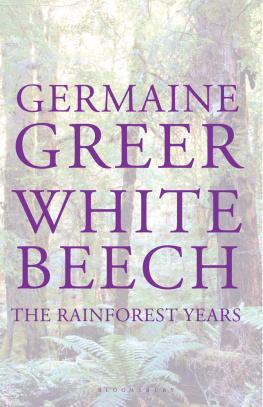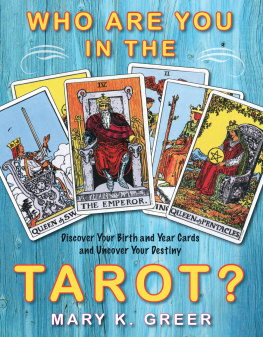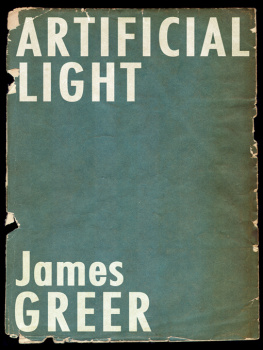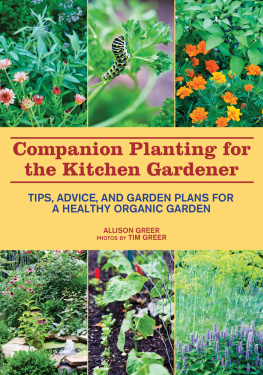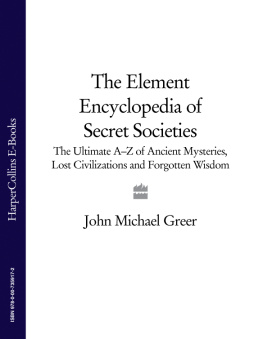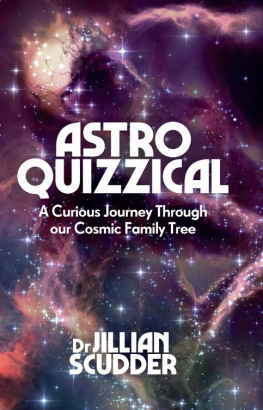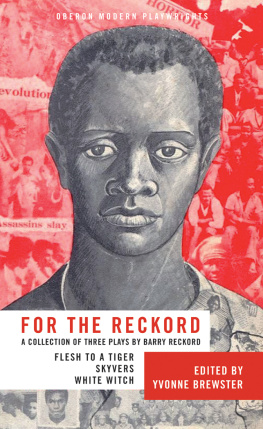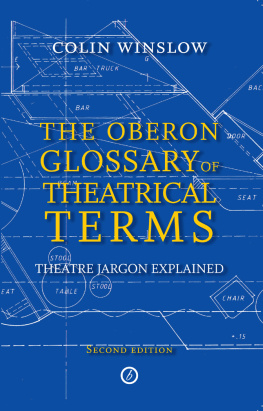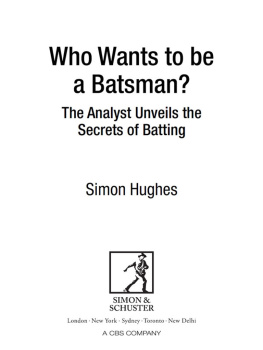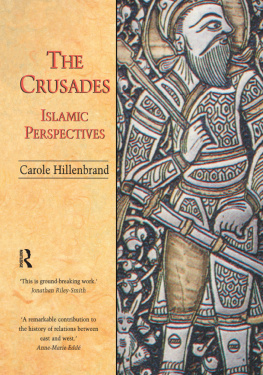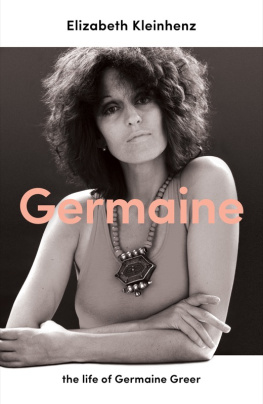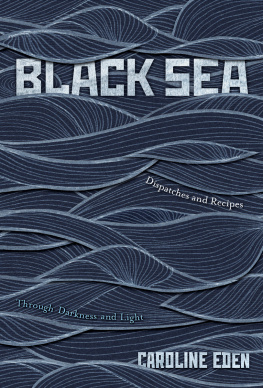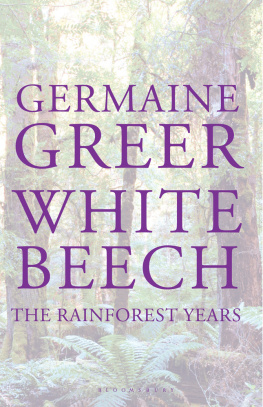Greer - White Beech: the Rainforest Years
Here you can read online Greer - White Beech: the Rainforest Years full text of the book (entire story) in english for free. Download pdf and epub, get meaning, cover and reviews about this ebook. City: New York, year: 2014;2015, publisher: Bloomsbury Publishing USA, genre: Detective and thriller. Description of the work, (preface) as well as reviews are available. Best literature library LitArk.com created for fans of good reading and offers a wide selection of genres:
Romance novel
Science fiction
Adventure
Detective
Science
History
Home and family
Prose
Art
Politics
Computer
Non-fiction
Religion
Business
Children
Humor
Choose a favorite category and find really read worthwhile books. Enjoy immersion in the world of imagination, feel the emotions of the characters or learn something new for yourself, make an fascinating discovery.
- Book:White Beech: the Rainforest Years
- Author:
- Publisher:Bloomsbury Publishing USA
- Genre:
- Year:2014;2015
- City:New York
- Rating:5 / 5
- Favourites:Add to favourites
- Your mark:
- 100
- 1
- 2
- 3
- 4
- 5
White Beech: the Rainforest Years: summary, description and annotation
We offer to read an annotation, description, summary or preface (depends on what the author of the book "White Beech: the Rainforest Years" wrote himself). If you haven't found the necessary information about the book — write in the comments, we will try to find it.
White Beech: the Rainforest Years — read online for free the complete book (whole text) full work
Below is the text of the book, divided by pages. System saving the place of the last page read, allows you to conveniently read the book "White Beech: the Rainforest Years" online for free, without having to search again every time where you left off. Put a bookmark, and you can go to the page where you finished reading at any time.
Font size:
Interval:
Bookmark:
The author has a great many people to thank for the help, support, encouragement and advice she has been given over the twelve years since she encountered the forest at Natural Bridge. Some of their names might not appear in the list that follows, but this doesnt mean that she has forgotten them, but rather that she has never known their surnames.
She thanks first of all, the redoubtable CCRRS workforce, especially Garry Mills, Will Miller, Simon Valadares, Luke and Rachael Morphett, Michelle and Barry Walsh, Ben Yaun and Mitchell Philp, also Bronwen Mark and Andrew Campbell; Ann Polis, and her daughter Mary Polis, for being so ready to give whatever help and support they could, Mary particularly for legal advice which Friends of Gondwana Rainforest could not have afforded otherwise; Professor Paul McHugh and Andrew Hardwick for coming on board as trustees at what turned out to be a very difficult time, and for weathering the storm of refashioning the charity; Nick Diss FCA of Reardon and Co. and Robert Meakin PhD of Stone King LLP for sorting out the muddle; Stephen Bligh and Andrew Swarbrick for listening to her anguished queries and steering her towards a solution; Eddie Stern of C. Hoare and Co. and Lucy Zheng of National Australia Bank for their prudent oversight; Brian Bayne and Tim Green for offering to act as directors of Djurebil Pty Ltd; Lynne and Duncan Turpie for helping her to find Brian and Tim; Lui Weber and Rob Price both for their astonishing depth of knowledge of the CCRRS rainforest and their willingness to share it; Christopher Spain BSc (Hons), now principal ecologist at Biodiversity Assessment and Management, for his work on the Cave Creek macadamias, and Dr Conrad Hoskin of James Cook University, for showing her some of the rarer fauna. Her debt to David Jinks should be obvious and she is very aware of the interest taken in the project by Dr Bill McDonald, and the friendliness of such rainforest heroes as Nan and Hugh Nicholson and Gwen Harden; for sharing expertise and supplying CCRRS with plants, Charlie and Cathy Booth at Bush Nuts Native Nursery, Tallebudgera Valley, Kris and Kim Kupsch of Ooray Orchards, Burringbar, and Lance, Sally and Matt Fitzgerald and Dave Woodlee at Burringbar Rainforest Nursery; for advice and assistance in selection of potting media, Tony Mullan and everyone at Green Fingers.
The authors thanks also go to the staff of the many libraries, archives and museums where she has foraged for information about the Numinbah Valley, its flora and fauna, and its human history. These include the National Library of Australia, the State Library of New South Wales, the Queensland State Archives, the Cambridge University Library, the Library of the University of Queensland, the National Archives (UK), the British Library, the Gold Coast City Library, the Tweed Heads Historical Society, the Richmond-Tweed Regional Library, Lismore, the Tweed River Historical Society, Murwillumbah, Murwillumbah Historical Society Inc., and in particular the Institute of Aboriginal and Torres Strait Islander Studies for expert help sensitively and discreetly given. Other archivists and scholars have given her help anonymously through websites and databases; her debt to them is obvious. Every day she has occasion to bless the International Plant Name Index, the Australian Plant Name Index, The Plant List, Tropicos and Botanicus. She also thanks Dr Mark Nesbitt of the Economic Botany Collection at the Royal Botanic Gardens, Kew, for help generously given on the occasion of her visit to the collection. Special thanks go to Brian and Margaret Palmer who introduced her to the conservation work going on in Northland NZ, and to John and Catherine Hawley of Maranui Conservation Ltd who took the time and trouble to familiarise her with the Gondwanan rainforest of the Brynderwyns-Bream Tail area.
Her sister Alida Jane Burke, and her husband Peter have let her drone on about the forest for hours without complaint; her brother Barry and his family have shown an abiding confidence in the value of the project even when she was wavering. Professor Jenny Morton has done her considerable best to turn the author into a scientist. The authors surrogate Fink family, especially Leon and Margaret, and Hannah Fink and her husband Andrew Shapiro, have helped her in every imaginable way. Don and Janet Holt were charming and hospitable hosts at Delmore Downs. Erwin and Adrienne Weber have served the cause of sustainability much longer than she has, and she values their example and advice. Judy Diamond and Kerry Broome have been good mates and have kept a watching brief at Cave Creek.
Above all, she thanks the denizens of the Cave Creek rainforest, vegetable and animal; their lust for life is what has transformed her uncertain efforts to rebuild the forest into a triumph over the forces of depletion. This it is that makes her dare to hope that it is not too late to save this most enchanting of small planets.
Germaine Greer is an Australian academic and journalist, and a major feminist voice of the mid-twentieth century. She gained her Ph.D. from the University of Cambridge in 1967. She is Professor Emerita of English Literature and Comparative Studies at the University of Warwick. Greers ideas have created controversy ever since The Female Eunuch became an international bestseller in 1970. She is the author of many other books including Sex and Destiny: The Politics of Human Fertility (1984); The Change: Women, Ageing and the Menopause (1991); The Whole Woman (1999) and Shakespeares Wife (2007).
The Australian writer Rosa Praed, who was born in 1851, spent her early childhood not far from Numinbah, at Bromelton on the Logan. She hardly noticed that her family was poor, because she had the riches of the rainforest.
... a huge Moreton Bay fig tree... gave us more delicious fruit than any we could get in the garden. Then there were mulgams native raspberries peculiar to the Logan; and there was the chucky-chucky, a most pleasant tasting wild plum, which had a way of hanging tantalisingly over the water, so that if the pool were deep, there was a little difficulty in gathering it. The geebong was not so nice its fruit was slimy and rather sickly, though not unpalatable... There is no end to the delights of a scrub.
Little Rosa was more easily pleased than todays children, who would never dream of putting a mulgam or a chucky-chucky into their mouths. Mulgam or, in his spelling, malgum, is listed by Gresty as the local Aboriginal name for the wild raspberry of the Numinbah Valley (Gresty, 62, 72). According to the Macquarie Dictionary the chucky-chucky is usually the fruit of the American snowberry, or the Tasmanian Gaultheria. Praeds geebong is nowdays better known as geebung, a name given to various Persoonia species. In Western Australia and South Australia geebungs are known also as Snottygobbles.
In the Cave Creek rainforest at all times of the year there is fruit. Sometimes there is so much squishy fruit underfoot that you find yourself walking in jam. Most prodigal are the figs, being in fruit all the year round. The botany of figs is still in its infancy, which is the kindest way of saying that the botanists have signally failed to answer any of the big questions about figs. What we think of as the fruit of a fig is actually a hollow structure called a synconium, like an inside-out umbel, containing hundreds of male pollen-bearing and/or female seed-forming flowers. In about half the 8001,000 fig species in the world the fig contains flowers of both sexes; in the other half the synconia are unisexual. All fig species breed their own pollinators, tiny symbiotic wasps, inside the synconia; the adult wasps travel from fig to fig through the tiny hole at the bottom, carrying pollen from the male synconia to the female, or from one bisexual synconium to another. Some synconia will be visited by more than one species of fig wasp, and some of the wasps are cuckoo-wasps that live on the flesh of the synconium, or the seeds or the wasp larvae in it.
Next pageFont size:
Interval:
Bookmark:
Similar books «White Beech: the Rainforest Years»
Look at similar books to White Beech: the Rainforest Years. We have selected literature similar in name and meaning in the hope of providing readers with more options to find new, interesting, not yet read works.
Discussion, reviews of the book White Beech: the Rainforest Years and just readers' own opinions. Leave your comments, write what you think about the work, its meaning or the main characters. Specify what exactly you liked and what you didn't like, and why you think so.

